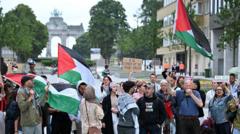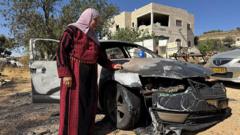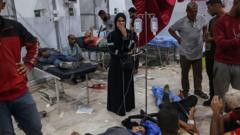As the situation continues to unfold, over 500 Palestinians have reportedly been killed while reaching for aid amidst perilous conditions.
A Month of Chaos: Gunfire and Casualties in Gaza's New Aid System

A Month of Chaos: Gunfire and Casualties in Gaza's New Aid System
In the aftermath of a contentious aid distribution plan in Gaza, gunfire and chaos overshadow humanitarian efforts.
One month after the implementation of a US- and Israeli-supported aid distribution strategy in Gaza, a series of videos analyzed by BBC Verify highlight a grim reality: repeated gunfire and chaotic scenes near aid collection points. The Hamas-run ministry of health in Gaza claims that over 500 individuals have lost their lives while seeking aid, with approximately 4,000 more suffering injuries. Most of the fatalities have been attributed to Israeli fire by local officials and witnesses.
While BBC Verify has been unable to conclusively determine the source of the violence, it paints a picture of confusion and persistent danger. The Israel Defense Forces (IDF) maintain that they have fired "warning shots" at individuals perceived as threats. In a statement, the IDF accused Hamas of hampering food distribution efforts, claiming they exploit the humanitarian crisis for political gain.
The aid distribution initiative, which began operations on May 26, was introduced following a partial easing of a blockade that lasted 11 weeks. A total of four aid sites were established in areas controlled by the IDF, under the management of security contractors working for the Gaza Humanitarian Foundation (GHF). Recently, the US government announced a $30 million funding package for the GHF, marking the first direct financial contribution to the effort.
From the beginning, the UN raised concerns about what it describes as the militarization of humanitarian assistance, warning that the new strategy would require Gazans to traverse perilous terrain to obtain food. Shortly after the program launched, numerous Palestinians were killed while attempting to receive aid, resulting in widespread international condemnation.
Acknowledging the ongoing issue, the IDF stated that its forces engage in "systematic learning processes" to improve their response and reduce friction with civilians. However, Israeli government spokesperson David Mencer dismissed claims of high fatality rates, arguing that reports of hundreds of deaths are unfounded.
The dire scenario is particularly highlighted by the Red Cross, which reported activating mass casualty procedures at its field hospital in Rafah multiple times since the distribution began. Many patients arrived with gunshot wounds linked to their attempts to access aid.
The UN's human rights office classified the killing of Palestinians seeking assistance as a "likely war crime," emphasizing that any deliberate targeting of civilians could violate international law. Chaos was evident as clips surfaced showing individuals scrambling for safety amid automatic gunfire during aid collection.
On June 1, several tragic incidents resulted in multiple deaths as people gathered near aid sites, and on June 17, witnesses described IDF fire targeting a crowd waiting for aid, leading to further fatalities. The IDF acknowledged that such incidents occurred near an unplanned aid distribution site and expressed regret for harm to uninvolved individuals.
Despite calls for safer access to humanitarian aid, the GHF reports that it has successfully distributed around 46 million meals to two million Gazans in its first month. The organization aims to scale up its operations, emphasizing the necessity for increased aid to mitigate the prevailing urgency and uncertainty faced by the population.
This unsettling situation continues to unfold, marked by significant human suffering amid efforts to deliver critical assistance. Additional reporting and verification into these events are ongoing.





















